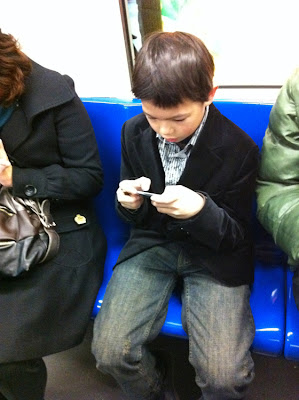Winter is upon us here in Shanghai.
The trees have bundled up.
Parker and Peter have changed their biking wear.
And Santa is making guest appearances all over
town.
In our apartment complex, the only sign that
Christmas is approaching is a small string of blinking lights that adorns a
single window. Ditto for the street below. But if you venture downtown, or to a
shopping mall, you find Christmas cheer galore.
There's also plenty of Christmas music. The other day we went to a restaurant near the university, a high-end place where we were the only Westerners. But when we walked into the lobby, we were greeted by Feliz Navidad. Various Christmas tunes (mostly bad cover versions) played in the background throughout the meal. It's the same all over town.
There's also plenty of Christmas music. The other day we went to a restaurant near the university, a high-end place where we were the only Westerners. But when we walked into the lobby, we were greeted by Feliz Navidad. Various Christmas tunes (mostly bad cover versions) played in the background throughout the meal. It's the same all over town.
We see plenty of approaches to holiday celebration.
A downtown hotel set up this gingerbread house/shop
in its lobby.
A department store outfitted its elephants.
Apple dressed its Shanghai geniuses in red shirts.
Christmas pandas, anyone?
Our local Wal Mart has a good-sized Christmas
section, even though virtually all its customers are Chinese. (We went there to
get a space heater because our apartment, like most Shanghai apartments, has
terrible heat!)
Some of the stuff is familiar.
Some isn't. Dragons or reindeer? You make the call.
We thought we made a sensible tree choice. Expats in
the French Quarter were paying big RMB for semi-real conifers.
The main point of all this Christmas cheer seems
to be to sell things (surprise, surprise). Our friends tell us that Christmas
stuff first showed up in the late 1990s, as China started becoming
more capitalistic.
If a billion Chinese people (and their aunties!) could
be inspired to buy each other Christmas presents someone would make some
serious money.
Here in China, some people would see that as a
good thing. Unlike folks in the U.S., those in China save huge amounts of money. This means that
much of China's economic growth depends on exports – on people in other
countries buying the stuff they make. Chinese leaders would like to see more of
that stuff sold at home (for more on the challenges faced by Chinese families,
see: http://www.nytimes.com/2011/10/10/business/global/households-pay-a-price-for-chinas-growth.html?scp=2&sq=Chinese%20consumers&st=cse).
If a foreign holiday like Christmas helps, well . . .
Of course for us, the Christmas season also means
another important holiday.
Parker started off his 11th birthday with a
three-computer Skype with friends (from left: Kiran and Elias, Schuyler and
Bradley and Will Gray).
He got a great rendition of "Happy
Birthday" (to see the video version, go to: http://www.flickr.com/photos/quarterscale/6542295579/in/set-72157627461266055)
We cycled off for breakfast at one of Shanghai's
best dim sum restaurants.
Then it was on to the slaughterhouse for a round
with his favorite Formula One game.
Happily, the Ferrari cafe had caught the Christmas
spirit.
After some quality time with his new iPod Touch (thanks, California clan!) he
donned his new, hand-tailored velvet jacket and we headed to his favorite
Japanese restaurant for dinner.
Shintori is a stylish place, and Christmas is no
exception.
If you look closely, you'll see that the waiter is
wearing a black Santa hat.
A marvelous end to a
marvelous day. Happy Birthday Parker!





































































